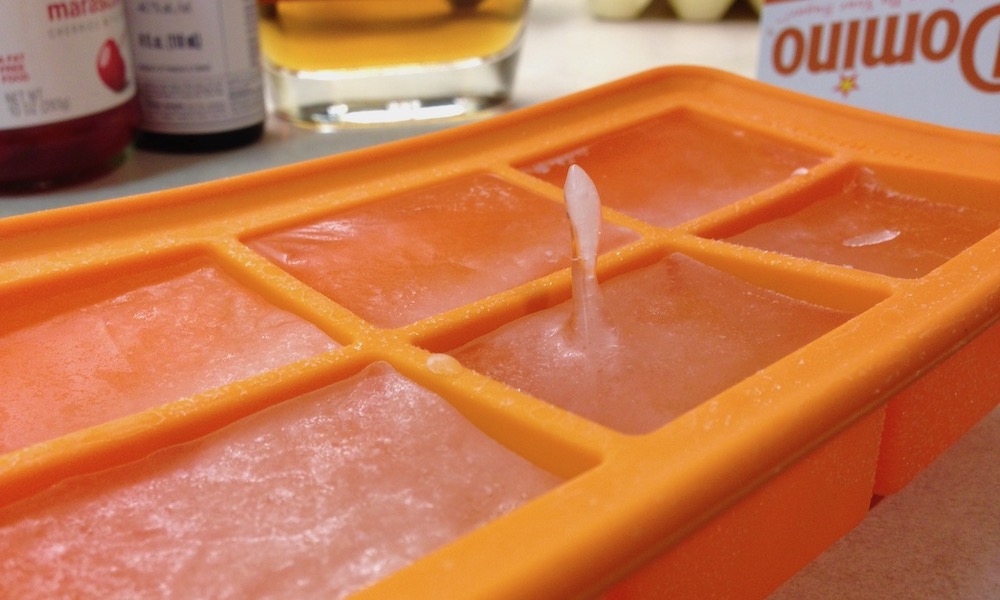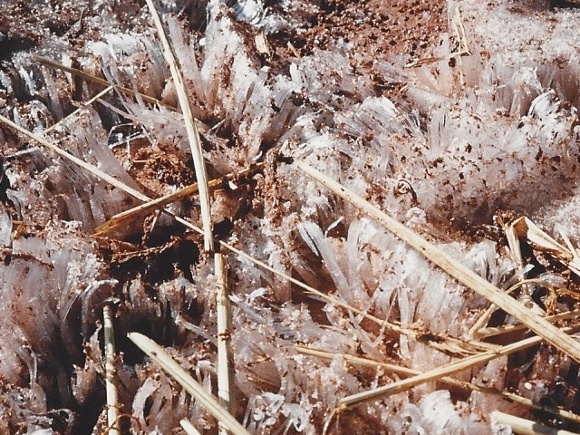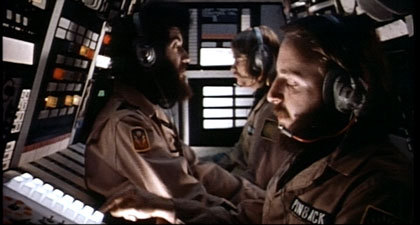Ice Spikes, Building Science, & Sci-Fi Movies — A Little Friday Fun

I love bizarre stuff. I love science. When those two come together, it’s almost better than ice cream. And speaking of ice, that’s what I’m talking about. Wednesday morning, I filled my orange silicone ice cube tray with tap water. When I opened the freezer that evening to get ice for my Old Fashioned cocktail, I found something really interesting. Take a look at the photo above, and you’ll see what I mean.
One of the biggest tasks in building science is to understand how water works and to prevent moisture problems. Down here in IECC climate zone 3, we don’t often deal with water in the solid phase, but when I saw this in my freezer, it made me think of something I read in Bill Rose’s excellent book, Water in Buildings.
On page 152 of his book, Rose shows a photo of a rare formation of ice crystals protruding from the ground. I actually saw some of those here in Georgia back in 2001 when I was building a home on our famous red clay soil (photo below).

One morning when I went out to the job site, I saw an area with a miniature forest of the ice crystals you see above. According to Rose, they form in certain conditions when the air and soil surface are freezing, but the water below the surface is liquid. Hydraulic pressure pushes water up through the frozen surface, where it freezes. The pressure keeps pushing and the crystal grows taller.
How cool is that?!
As it turns out, my ice cube tray was doing something similar. This is the first time in my life I’ve seen this phenomenon, but according to Cal Tech, it’s not because of the silicone tray, which was my initial guess. On their page about it, they say it results when the surface of the ice freezes and then ice from below starts floating up and getting pushed up more and more, like the ice crystals coming out of the ground. The image below, from their page, illustrates the process.
They show one photo of a regular blue plastic ice cube tray with nearly every cube growing a spike! Check it out. The odd thing about my ice spike, though, is that I used tap water, and the Cal Tech page says it most often happens with distilled water because the presence of salts kills the spikes. I haven’t tested it, but maybe our Dekalb County water doesn’t have a lot of salts.
I know it’s not as directly applicable to what we talk about here as ice dams and condensation, but now you’ll know a little about ice spikes in case you see them at your house some day. Who knows?
And speaking of plastic ice cube trays, if you’re old enough, you might recall those translucent ones that were all the rage in the ’70s. If you aren’t or don’t, here’s a photo of one for you:

It’s from one of the coolest low-budget sci-fi movies ever: Dark Star, starring John Carpenter. I’ve read that he made it while he was in film school, hence the ice cube tray. Another great trick was the alien onboard their space ship made from a beach ball. Really fun movie. I recommend it highly. If you want a heavier low-budget film from a new director, see Eraserhead.
Now, if you’re wondering what Eraserhead has to do with ice spikes and why I’ve strayed even further from the topic of building science…well, let me know if you come up with something.
Have a great weekend, everyone!
Allison A. Bailes III, PhD is a speaker, writer, building science consultant, and the founder of Energy Vanguard in Decatur, Georgia. He has a doctorate in physics and writes the Energy Vanguard Blog. He is also writing a book on building science. You can follow him on Twitter at @EnergyVanguard.
Related Articles
When It Comes to Ice Dams, You CAN Fix Stupid!
Water Loves Cold and Other HVAC Duct Failure Stories
Why Did Painters Refuse to Paint Insulated Houses in the 1930s?
Comments are closed.
This Post Has 4 Comments
Comments are closed.


“Dark Star” is
. It doesn’t happen much around here and the schools aren’t what they used to be.
“Dark Star” is indeed a fun movie if you can stand a little camp. John Carpenter and Dan O’Bannon wrote it, and O’Bannon starred as Sgt. Pinback. But you will be disappointed if you expect to actually see Carpenter in the film, he is not on the credits I see.
Meanwhile here in Houston, a TV reporter is informing us about how if a liquid raindrop hits a below-32F tree branch or other object, it turns into something solid
Here in the mountains I see
Here in the mountains I see those ice spikes on the ground sometimes in winter when hiking. In places where it’s really exposed and so stays constantly windy and cold in winter, I’ve seen something really similar pointed sideways (leeward?) on trees branches and shrubs.
The ice cube trays I
The ice cube trays I experienced in the 1970s were aluminum with removable separators. Those beasts had a handle that forcibly rotated the separator slats, breaking the ice loose.
I still remember the freezer burns that arose handling those things, as well as my mother’s wrath when I’d return a tray to the freezer w/o refilling it!
I spent 45 years designing
I spent 45 years designing and building project in all parts of Alaska. The Native Alaskans have many names for snow and Ice that describe almost an infinite variety of textures, stability and visual effects. I find it very interesting that H20 is the only thing that expands as it phase changes from liquid to solid. When dealing with permafrost foundation conditions I have seen piles jacked 5 feet above their original position by frost heave. A series of freeze/thaw cycles and surrounding soils that hold moisture are the culprits. To meet the criteria for a PE licensee in Alaska you have to pass an Arctic Engineering class that contains a great deal of material that deals with engineering ice structures and dealing with permafrost issues. I could and probably should write a book about what we learned from the experience.